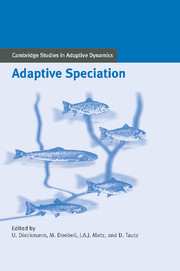A - Theories of Speciation
Published online by Cambridge University Press: 05 July 2014
Summary
Theories of speciation, in the past often couched in verbal terms, should explain how ecological divergence and genetically determined reproductive isolation evolve between lineages that originate from single, genetically homogeneous ancestral populations. As Will Provine highlights in Chapter 2, the predominant perspective for a long time was that reproductive isolation emerges as a by-product of other evolutionary processes, through the incidental accumulation of genotypic incompatibility between related species. It is easiest to imagine that such incompatibilities arise when subpopulations become geographically isolated and henceforth evolve independently: genetic distance between them is then expected to increase with time. Thus, “given enough time, speciation is an inevitable consequence of populations evolving in allopatry” (Turelli et al. 2001). On a verbal level this theory of allopatric speciation appears both simple and convincing. This apparent theoretical simplicity has contributed to the view that the allopatric mode of speciation is the prevalent one – a perspective that has found its most prominent advocate in Ernst Mayr (Chapter 2).
Unfortunately, not only is the simplicity of the usual accounts of allopatric speciation based on the poorly understood concept of genetic incompatibility, but simplicity in itself is no guarantee for ubiquitous validity. Other plausible, but theoretically more intricate, mechanisms for the evolution of reproductive isolation in the absence of geographic isolation have been proposed. Recent approaches have focused attention on adaptive processes that lead to ecological and reproductive divergence as an underlying mechanism for speciation processes – a change in emphasis that occurred concomitantly with a shift in biogeographic focus from allopatric scenarios to parapatric speciation between adjacent populations or fully sympatric speciation. This was foreshadowed by the idea of reinforcement (the evolution of prezygotic isolation through selection against hybrids) and has culminated in theories of sympatric speciation, in which the emergence and divergence of new lineages result from frequency-dependent ecological interactions.
- Type
- Chapter
- Information
- Adaptive Speciation , pp. 31 - 35Publisher: Cambridge University PressPrint publication year: 2004

